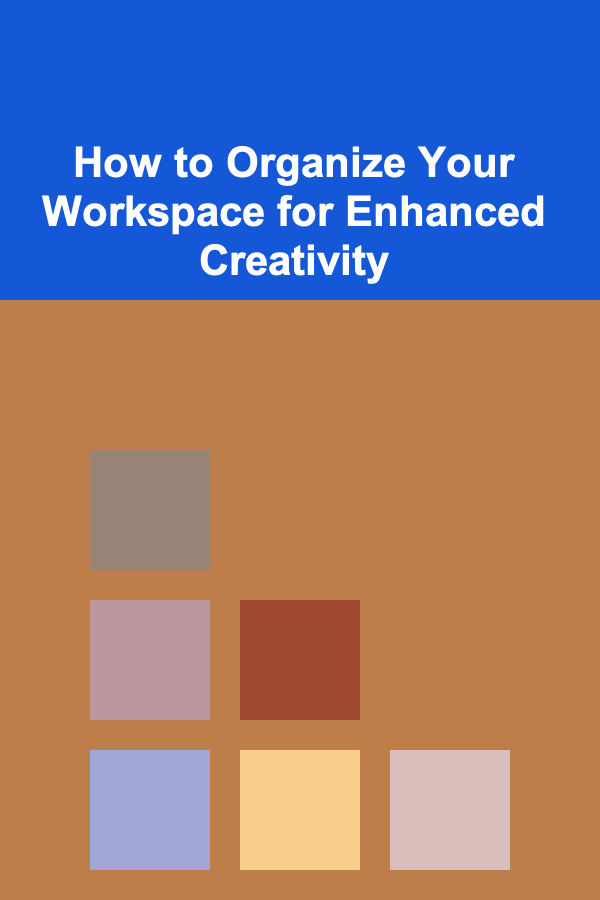
How to Organize Your Workspace for Enhanced Creativity
ebook include PDF & Audio bundle (Micro Guide)
$12.99$9.99
Limited Time Offer! Order within the next:

In an era where creativity is a prized asset, the environment in which we work plays a crucial role in fostering our imaginative capabilities. A well-organized workspace can significantly enhance your creativity, enabling you to think more freely and innovatively. Whether you're an artist, writer, designer, or engaged in any creative endeavor, the organization of your workspace can impact your productivity, focus, and overall mental clarity.
This comprehensive article will explore various strategies to organize your workspace effectively, with a focus on enhancing creativity. We'll delve into psychological aspects, practical tips, and design considerations that contribute to a more inspiring and functional environment.
Understanding the Importance of Workspace Organization
1. The Psychological Impact of Environment
a. Clutter and Distraction
A cluttered workspace can lead to feelings of overwhelm and distraction, which stifle creativity. Studies have shown that excessive clutter can negatively affect cognitive function, making it difficult to concentrate and brainstorm innovative ideas.
b. Emotional Well-Being
An organized space promotes feelings of calm and control. When your environment is tidy and manageable, you are less likely to experience stress, allowing creative thoughts to flow more freely.
2. Inspiration Through Design
a. Aesthetic Appeal
The aesthetics of your workspace can influence your mood and creativity. Bright colors, inspiring artwork, and visually appealing arrangements can ignite motivation and imagination.
b. Personal Touch
Incorporating personal items---such as photographs, mementos, or artworks---can create an emotional connection to your space, making it a source of inspiration.
Assessing Your Current Workspace
1. Reflect on Your Needs
Before diving into organizational strategies, take time to assess your current workspace:
- What are your primary activities? Determine what tasks you perform most frequently.
- What tools do you need? Identify essential tools and materials required for your creative work.
- What distracts you? Recognizing sources of distraction helps you devise strategies to mitigate them.
2. Evaluate Space
Assess the physical layout of your workspace. Measure dimensions, observe lighting conditions, and consider acoustics, which can all affect creativity.
Practical Strategies for Organizing Your Workspace
1. Declutter and Simplify
a. Remove Unnecessary Items
Begin by removing everything from your workspace and sorting through items. Keep only what is essential for your creative projects.
b. Use the Four-Box Method
Utilize the four-box method to categorize items:
- Keep: Items you use regularly.
- Donate/Sell: Items still in good condition but no longer useful to you.
- Trash: Items that are broken or expired.
- Store: Seasonal or infrequently used items.
2. Create Dedicated Zones
a. Define Activity Areas
Segment your workspace into defined areas based on different activities. For example:
- Creative Zone: For brainstorming and idea generation. Include comfortable seating and inspiration boards.
- Work Zone: For focused tasks. Use a sturdy desk and ergonomic chair.
- Collaboration Zone: If applicable, create a space designed for teamwork and discussion.
b. Minimize Cross-Zone Distractions
Limit items in each zone to those relevant to that area's purpose. This separation encourages focus and minimizes the temptation to switch tasks unnecessarily.
3. Optimize Storage Solutions
a. Utilize Vertical Space
Maximize vertical space by using shelves, pegboards, or wall-mounted organizers. This approach keeps frequently used items accessible while freeing up desk space.
b. Invest in Functional Furniture
Consider multifunctional furniture that combines storage and work surfaces:
- Storage Ottomans: Can serve as seating and conceal supplies.
- Rolling Carts: Offer mobility and easy access to tools or materials.
c. Establish Clear Storage Systems
Create designated storage systems for different categories of items:
- Art Supplies: Use labeled bins or drawers.
- Writing Materials: Organize pens, notebooks, and papers in desktop organizers.
- Reference Materials: Store books or manuals within easy reach but out of your primary workspace.
4. Leverage Technology Wisely
a. Digital Organization
Digital clutter can be just as distracting as physical clutter. Regularly organize your digital files and applications:
- Folder Structures: Develop a clear folder structure for easy retrieval.
- Cloud Storage: Use services like Google Drive or Dropbox for secure access to files across devices.
b. Productivity Tools
Utilize productivity apps that help manage tasks and schedules. Tools such as Trello, Asana, or Notion can assist in organizing ideas and tracking projects.
5. Personalize Your Space
a. Incorporate Personal Elements
Add items that reflect your personality and values:
- Artwork: Hang pieces that inspire you.
- Photos: Display images of loved ones or places that motivate you.
- Plants: Introduce greenery to improve air quality and add a sense of tranquility.
b. Color Psychology
Consider the psychological effects of color when personalizing your workspace. For example:
- Blue: Promotes calmness and focus.
- Yellow: Sparks creativity and optimism.
- Green: Enhances balance and harmony.
6. Manage Lighting Effectively
a. Natural Light
Whenever possible, position your workspace near windows to take advantage of natural light. Research indicates that exposure to daylight can improve mood and productivity.
b. Task Lighting
In addition to natural light, incorporate task lighting to illuminate specific areas. Adjustable desk lamps can provide targeted light for detailed work.
7. Foster a Routine
a. Establish Work Hours
Setting regular work hours can create a rhythm, helping you enter a focused mindset more easily. Consistency aids in establishing creative habits.
b. Take Breaks
Incorporate breaks into your routine to prevent burnout. Short intervals of rest allow your mind to recharge and can lead to fresh insights.
8. Limit Distractions
a. Control Noise Levels
Consider the level of noise in your workspace. If silence is preferable, use noise-canceling headphones or soft background music to minimize distractions.
b. Digital Detox
Set boundaries for technology and social media usage during creative work. Allocate specific times to check emails or social media to maintain focus.
Maintaining Your Organized Workspace
1. Regular Maintenance
Make it a habit to reassess and tidy your workspace regularly. Dedicate a few minutes at the end of each day to put things back in their designated spots.
2. Seasonal Overhaul
Consider conducting a more thorough organizational overhaul at the change of seasons. This practice allows you to adjust your space according to changing needs or projects.
3. Stay Flexible
As your creative process evolves, so too should your workspace organization. Be open to experimenting with different layouts and systems to find what works best for you.
Creative Inspirations for Workspace Design
1. Artistic Spaces
If you're an artist, consider setting up an easel and painting area distinct from your drawing or sketching zone. This separation fosters different modes of creativity.
2. Co-Working Space
For those who thrive in collaborative environments, design a co-working space that facilitates communication and teamwork. Use movable furniture to accommodate group projects.
3. Nature-Infused Spaces
Incorporate natural elements into your workspace, such as wood finishes or stone accents. Biophilic design is known to enhance creativity and well-being.
4. Minimalist Approach
For some, minimalism provides clarity and focus. A clean, uncluttered workspace with only essential items can drive creativity by reducing distractions.
Conclusion
Organizing your workspace for enhanced creativity is a multifaceted endeavor that encompasses both physical space and mental clarity. By implementing effective organizational strategies, you create an environment that nurtures innovation, reduces stress, and ultimately supports your creative pursuits.
Through thoughtful assessment, personalized design, effective storage solutions, and ongoing maintenance, you can foster a workspace that empowers you to tap into your creative potential. Embrace the process, experiment with different approaches, and watch as your creativity flourishes in an organized and inspiring environment.
Reading More From Our Other Websites
- [Home Storage Solution 101] How to Create a Pantry Organization System for Easy Meal Prep
- [Organization Tip 101] How to Transform a Small Space into a Functional Sensory Room
- [Organization Tip 101] How to Organize Your Digital Marketing Campaigns
- [Home Family Activity 101] How to Make Family "Simon Says" More Exciting and Challenging
- [Organization Tip 101] How to Use Storage Bins for Seasonal Clothing
- [Toy Making Tip 101] How to Build a DIY Toy‑Making Studio on a Small Budget
- [Personal Financial Planning 101] How to Prepare for Major Life Changes: Financial Tips for Transitions
- [Home Party Planning 101] How to Throw a Surprise Party at Home Without Giving It Away
- [Personal Care Tips 101] How to Incorporate Face Serum into Your Nighttime Skincare Routine
- [Home Soundproofing 101] How to Soundproof Your Home's Exterior for Privacy

Essential Financial Planning Tools Every Budgeter Should Know About
Read More
How to Clean and Maintain Your Home's Chimney
Read More
How to Make Your Own Family Board Game from Scratch
Read More
How to Use Financial Modeling to Make Money
Read More
How to Create Transparent AI Systems
Read More
How To Choose Your First Programming Language
Read MoreOther Products

Essential Financial Planning Tools Every Budgeter Should Know About
Read More
How to Clean and Maintain Your Home's Chimney
Read More
How to Make Your Own Family Board Game from Scratch
Read More
How to Use Financial Modeling to Make Money
Read More
How to Create Transparent AI Systems
Read More